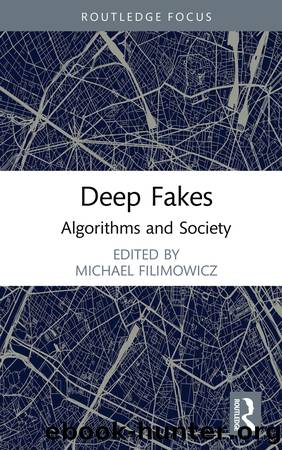Deep Fakes by Michael Filimowicz;

Author:Michael Filimowicz; [Неизв.]
Language: eng
Format: epub
Publisher: Taylor & Francis (Unlimited)
Published: 2022-12-03T21:00:00+00:00
Technology
Efforts by technology and social media companies to tackle deep fakes have taken on greater prominence since the 2020 US presidential election. Facebook, for instance, announced in January 2020 that it would remove deep fakes from its platform.7 It has also developed technical tools for deepfake detection to reveal the origins of uploaded deep fakes and identify the design of the AI model used (Shead, 2021). TikTok, in response to the highly realistic Tom Cruise content on the platform, has said that it will not act against Chris Umeâs @deeptomcruise account as it did not violate policies against harmful deep fakes (TikTok, 2020). In Asia, leading online platforms in China have implemented algorithmic detection techniques to ensure internal compliance to remove harmful content, including deep fakes which aim to mislead or deceive. For instance, Tencent has developed a product called Anti-Deepfake for businesses operating on its platform via Tencent Cloud (Tencent, n.d.).
Tech companies are not the only ones developing policies or products to tackle deep fakes. In Asia, technological innovations have been developed. For instance, Singaporeâs national identity scheme utilizes facial biometrics to not only detect the identity of a citizen but also to detect whether a person is genuinely present â that is, not a deepfake (McDonald, 2020). AI Singapore, a national artificial intelligence (AI) program, has also recently launched Trusted Media Challenge, an international competition to combat deep fakes, collaborating with news agencies in Singapore to provide a database of 800 videos (Kurohi, 2021). The Korea Advanced Institute of Science and Technology (KAIST) unveiled a deepfake detection mobile app KaiCatch, which calculates the likelihood of an uploaded image being manipulated (Yonhap News Agency, 2021). In India, FakeBuster, a deepfake detector, was developed to identify manipulated media on social media platforms (Dharmaraj, 2021). Apps such as Reface limit deepfake creation to ten-second videos or GIFs and are expanding digital watermarking to their users (Smith, 2020). Start-ups focusing on deep fakes as a core area of business are choosing to deploy the technology narrowly to avoid potential abuse. For instance, Kapwing, a start-up which makes video editing tools for influencers, limited its deepfake tools for its users (Hao, 2020).
Deepfake detection technology, however, has its limitations. Research has shown that even deepfake detectors can be tricked into misidentifying a deepfake video (Mirsky & Lee, 2021). The Tom Cruise deepfake videos created by Chris Ume, for instance, were able to fool detection software into thinking that the fake videos were authentic (Stern, 2021).8 While experts in digital video forensics agree that the videos were by far the most realistic and high quality they had seen, human video forensic analysts manually examined the videos and were able to spot tell-tale signs of inauthenticity (Kahn, 2021a). Technical methods for catching deep fakes have also thus far been unsuccessful in catching shallowfakes such as the altered video of Nancy Pelosi (Hao, 2019).
Download
This site does not store any files on its server. We only index and link to content provided by other sites. Please contact the content providers to delete copyright contents if any and email us, we'll remove relevant links or contents immediately.
Deep Learning with Python by François Chollet(12577)
Hello! Python by Anthony Briggs(9916)
OCA Java SE 8 Programmer I Certification Guide by Mala Gupta(9796)
The Mikado Method by Ola Ellnestam Daniel Brolund(9779)
Dependency Injection in .NET by Mark Seemann(9340)
Algorithms of the Intelligent Web by Haralambos Marmanis;Dmitry Babenko(8301)
Test-Driven iOS Development with Swift 4 by Dominik Hauser(7763)
Grails in Action by Glen Smith Peter Ledbrook(7697)
The Well-Grounded Java Developer by Benjamin J. Evans Martijn Verburg(7557)
Becoming a Dynamics 365 Finance and Supply Chain Solution Architect by Brent Dawson(7091)
Microservices with Go by Alexander Shuiskov(6859)
Practical Design Patterns for Java Developers by Miroslav Wengner(6777)
Test Automation Engineering Handbook by Manikandan Sambamurthy(6718)
Secrets of the JavaScript Ninja by John Resig Bear Bibeault(6419)
Angular Projects - Third Edition by Aristeidis Bampakos(6129)
The Art of Crafting User Stories by The Art of Crafting User Stories(5652)
NetSuite for Consultants - Second Edition by Peter Ries(5586)
Demystifying Cryptography with OpenSSL 3.0 by Alexei Khlebnikov(5392)
Kotlin in Action by Dmitry Jemerov(5066)
